Foundational Psychology: Operant Conditioning in Secondary School
VerifiedAdded on 2022/08/14
|11
|2903
|23
Essay
AI Summary
This essay analyzes a classroom scenario where a teacher, Mr. Tan, is struggling to manage his secondary school students due to their lack of participation and non-compliance. The essay begins by providing background information on the age group and their developmental stage, highlighting the psychological changes they undergo during adolescence. It then examines the range of behaviors displayed in the classroom, linking them to theories such as Erikson's stages of psychosocial development, social learning theory, Piaget's theory of cognitive development, and Kohlberg's theory of moral development. The core of the essay focuses on applying operant conditioning principles, including positive and negative reinforcement and punishment, to address the students' behaviors. It discusses the strengths and weaknesses of operant conditioning compared to other developmental theories and concludes with an evaluation of its suitability as an approach to behavioral change in this specific classroom context. The essay demonstrates how to apply operant conditioning to improve student participation and assignment completion, and to foster a more positive learning environment.
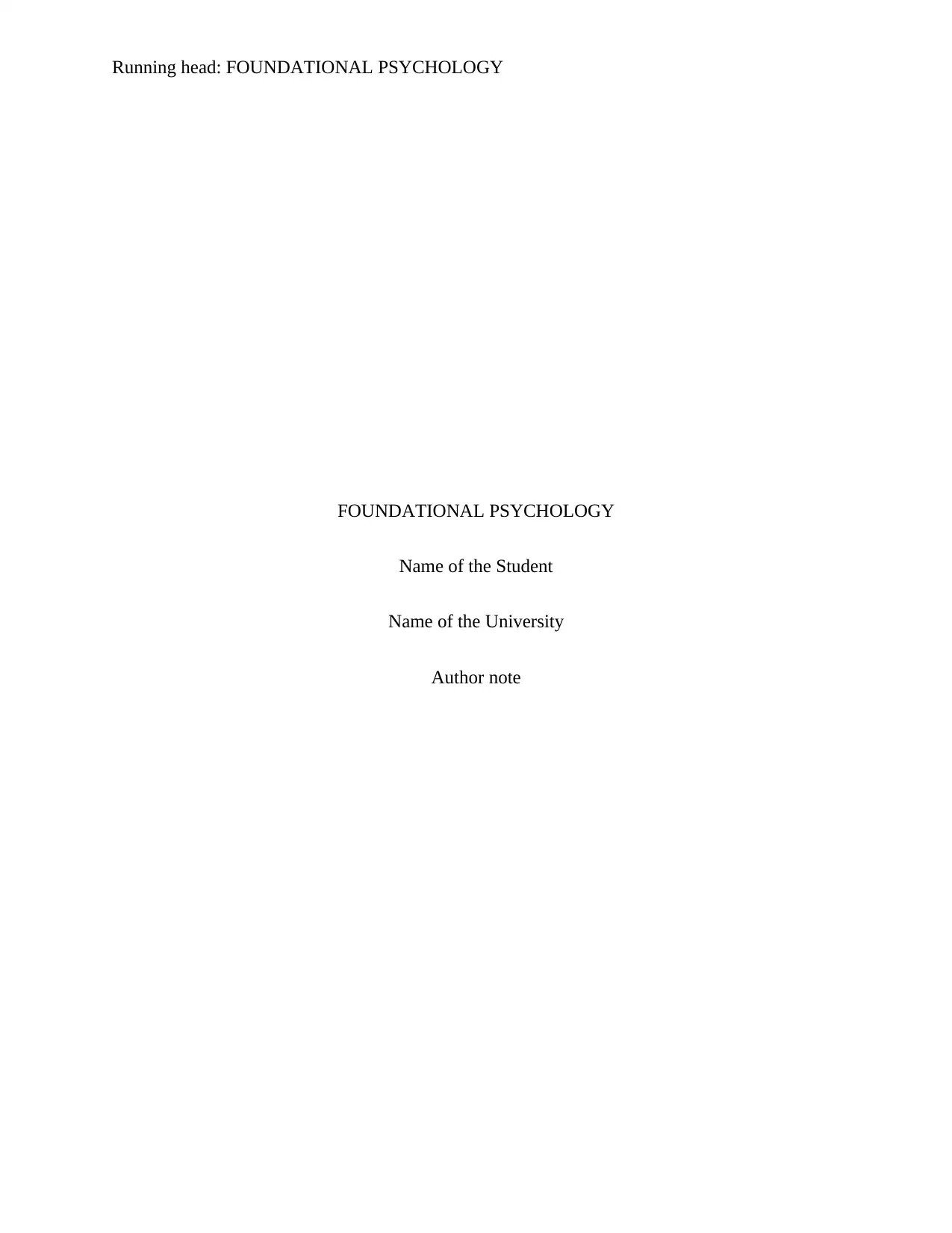
Running head: FOUNDATIONAL PSYCHOLOGY
FOUNDATIONAL PSYCHOLOGY
Name of the Student
Name of the University
Author note
FOUNDATIONAL PSYCHOLOGY
Name of the Student
Name of the University
Author note
Paraphrase This Document
Need a fresh take? Get an instant paraphrase of this document with our AI Paraphraser
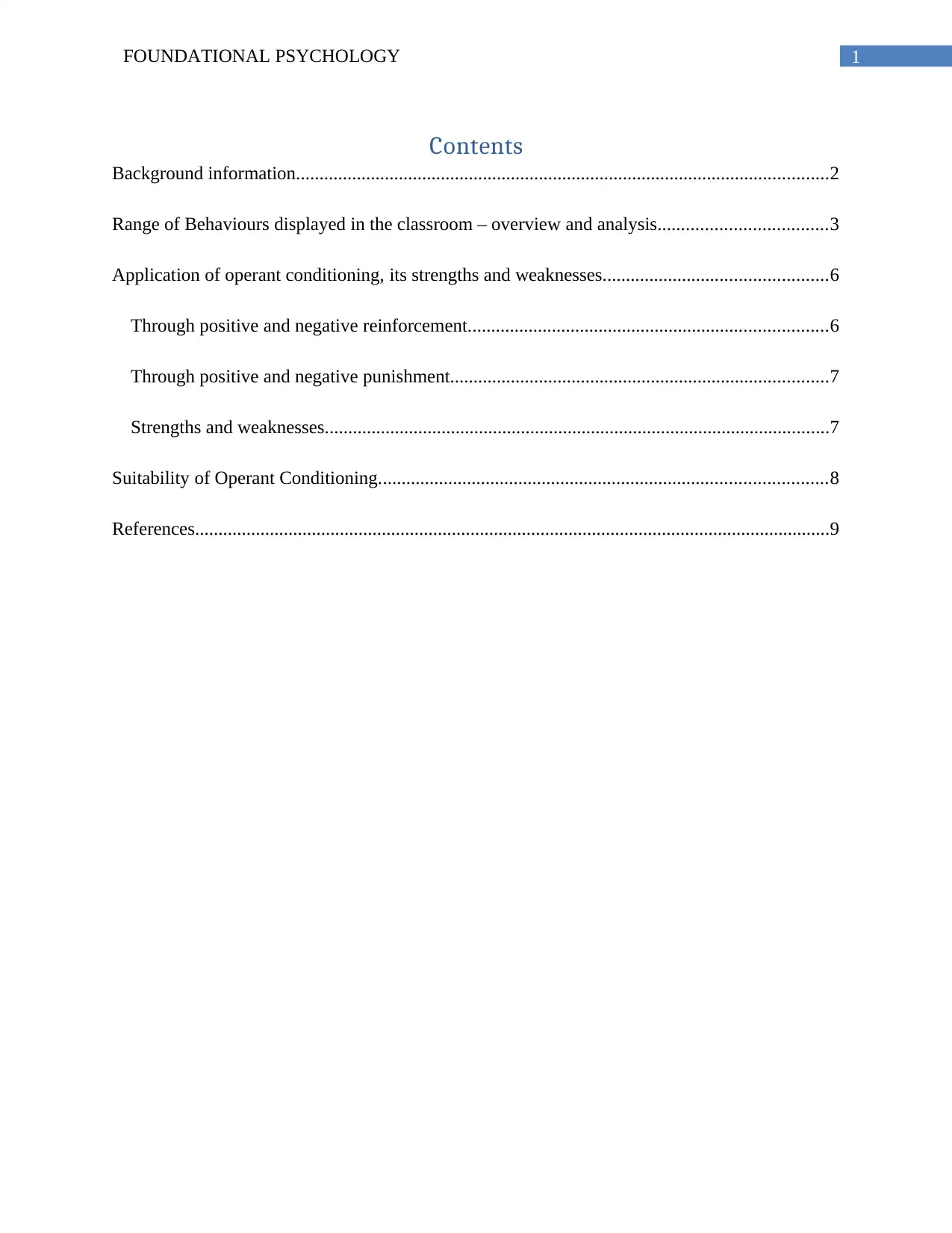
1FOUNDATIONAL PSYCHOLOGY
Contents
Background information..................................................................................................................2
Range of Behaviours displayed in the classroom – overview and analysis....................................3
Application of operant conditioning, its strengths and weaknesses................................................6
Through positive and negative reinforcement.............................................................................6
Through positive and negative punishment.................................................................................7
Strengths and weaknesses............................................................................................................7
Suitability of Operant Conditioning................................................................................................8
References........................................................................................................................................9
Contents
Background information..................................................................................................................2
Range of Behaviours displayed in the classroom – overview and analysis....................................3
Application of operant conditioning, its strengths and weaknesses................................................6
Through positive and negative reinforcement.............................................................................6
Through positive and negative punishment.................................................................................7
Strengths and weaknesses............................................................................................................7
Suitability of Operant Conditioning................................................................................................8
References........................................................................................................................................9

2FOUNDATIONAL PSYCHOLOGY
Background information.
Secondary year 2 students usually fall in the age group of 13 – 14 year old children. This
particular age group is the onset of the adolescence period, where the children make transition
from their childhood stage to the stage of adulthood (Curtis, 2015). This transition results in the
development of a variety of features that are both physical and psychological in nature. Even
though the physical changes are quite prominently visible in them, the psychological attributes
are much harder to observe. Curtis (2015) elaborates that the psychological attributes like
thought, emotions, behaviour and social roles involving interpersonal relationships are the ones
mostly affected in this phase and undergo the most radical changes. These changes can be quite
difficult for the person to deal with on his own, as the classroom in the current context has
shown. Mr. Tan’s Class consists of secondary 2 students who display similar attributes of not
being able to cope with the changes, especially through their non – participation in the class and
non – cooperation with the teacher. This is a common trait among a lot of students in the current
age group.
This essay deals with a wide range of behavioural and social psychological concepts and
theories, with special focus on operant conditioning by B.F. Skinner. In order to test the validity
of applying operant conditioning in the current context, the theory is also compared and
contrasted against several other relevant theories, precisely the theory of Moral Development by
Lawrence Kohlberg, Erikson’s stages of psychosocial development, Social Learning Theory by
Albert Bandura and the Cognitive Learning Theory by Jean Piaget.
Background information.
Secondary year 2 students usually fall in the age group of 13 – 14 year old children. This
particular age group is the onset of the adolescence period, where the children make transition
from their childhood stage to the stage of adulthood (Curtis, 2015). This transition results in the
development of a variety of features that are both physical and psychological in nature. Even
though the physical changes are quite prominently visible in them, the psychological attributes
are much harder to observe. Curtis (2015) elaborates that the psychological attributes like
thought, emotions, behaviour and social roles involving interpersonal relationships are the ones
mostly affected in this phase and undergo the most radical changes. These changes can be quite
difficult for the person to deal with on his own, as the classroom in the current context has
shown. Mr. Tan’s Class consists of secondary 2 students who display similar attributes of not
being able to cope with the changes, especially through their non – participation in the class and
non – cooperation with the teacher. This is a common trait among a lot of students in the current
age group.
This essay deals with a wide range of behavioural and social psychological concepts and
theories, with special focus on operant conditioning by B.F. Skinner. In order to test the validity
of applying operant conditioning in the current context, the theory is also compared and
contrasted against several other relevant theories, precisely the theory of Moral Development by
Lawrence Kohlberg, Erikson’s stages of psychosocial development, Social Learning Theory by
Albert Bandura and the Cognitive Learning Theory by Jean Piaget.
⊘ This is a preview!⊘
Do you want full access?
Subscribe today to unlock all pages.

Trusted by 1+ million students worldwide
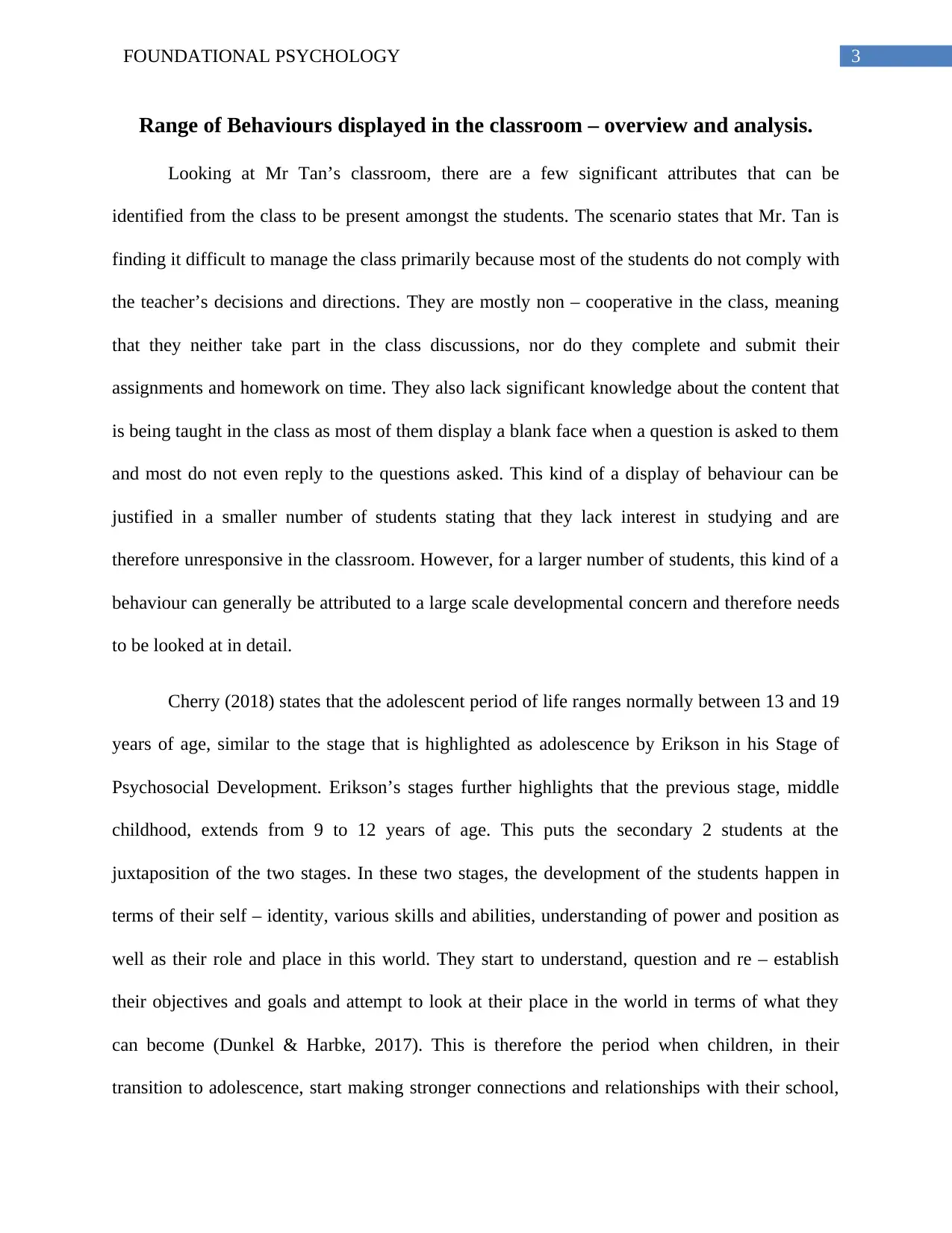
3FOUNDATIONAL PSYCHOLOGY
Range of Behaviours displayed in the classroom – overview and analysis.
Looking at Mr Tan’s classroom, there are a few significant attributes that can be
identified from the class to be present amongst the students. The scenario states that Mr. Tan is
finding it difficult to manage the class primarily because most of the students do not comply with
the teacher’s decisions and directions. They are mostly non – cooperative in the class, meaning
that they neither take part in the class discussions, nor do they complete and submit their
assignments and homework on time. They also lack significant knowledge about the content that
is being taught in the class as most of them display a blank face when a question is asked to them
and most do not even reply to the questions asked. This kind of a display of behaviour can be
justified in a smaller number of students stating that they lack interest in studying and are
therefore unresponsive in the classroom. However, for a larger number of students, this kind of a
behaviour can generally be attributed to a large scale developmental concern and therefore needs
to be looked at in detail.
Cherry (2018) states that the adolescent period of life ranges normally between 13 and 19
years of age, similar to the stage that is highlighted as adolescence by Erikson in his Stage of
Psychosocial Development. Erikson’s stages further highlights that the previous stage, middle
childhood, extends from 9 to 12 years of age. This puts the secondary 2 students at the
juxtaposition of the two stages. In these two stages, the development of the students happen in
terms of their self – identity, various skills and abilities, understanding of power and position as
well as their role and place in this world. They start to understand, question and re – establish
their objectives and goals and attempt to look at their place in the world in terms of what they
can become (Dunkel & Harbke, 2017). This is therefore the period when children, in their
transition to adolescence, start making stronger connections and relationships with their school,
Range of Behaviours displayed in the classroom – overview and analysis.
Looking at Mr Tan’s classroom, there are a few significant attributes that can be
identified from the class to be present amongst the students. The scenario states that Mr. Tan is
finding it difficult to manage the class primarily because most of the students do not comply with
the teacher’s decisions and directions. They are mostly non – cooperative in the class, meaning
that they neither take part in the class discussions, nor do they complete and submit their
assignments and homework on time. They also lack significant knowledge about the content that
is being taught in the class as most of them display a blank face when a question is asked to them
and most do not even reply to the questions asked. This kind of a display of behaviour can be
justified in a smaller number of students stating that they lack interest in studying and are
therefore unresponsive in the classroom. However, for a larger number of students, this kind of a
behaviour can generally be attributed to a large scale developmental concern and therefore needs
to be looked at in detail.
Cherry (2018) states that the adolescent period of life ranges normally between 13 and 19
years of age, similar to the stage that is highlighted as adolescence by Erikson in his Stage of
Psychosocial Development. Erikson’s stages further highlights that the previous stage, middle
childhood, extends from 9 to 12 years of age. This puts the secondary 2 students at the
juxtaposition of the two stages. In these two stages, the development of the students happen in
terms of their self – identity, various skills and abilities, understanding of power and position as
well as their role and place in this world. They start to understand, question and re – establish
their objectives and goals and attempt to look at their place in the world in terms of what they
can become (Dunkel & Harbke, 2017). This is therefore the period when children, in their
transition to adolescence, start making stronger connections and relationships with their school,
Paraphrase This Document
Need a fresh take? Get an instant paraphrase of this document with our AI Paraphraser

4FOUNDATIONAL PSYCHOLOGY
their teachers as well as their friends and other peers (Crocetti, 2017). Dunkel & Harbke (2017)
explains the current behaviour in terms of psychosocial concepts, stating that the development of
these relationships and attributes in the two stages are heavily influenced by the type of
interactions and experiences that they have with other people both inside and outside their social
groups. This is where the social learning theory also becomes important. It states that people
learn and imitate the behaviour that is most commonly present in a social group, indicating that
an individual in a social group tends to follow the normative behaviour present in that group
(Brenzina & Piquero, 2017). Looking back at Mr Tan’s class at this juncture, it can therefore be
identified that the students who are non - responsive in the class, are primarily in the transitional
period between preadolescence and adolescence. Therefore, their primary connection in the
classroom is their peers. If the peer behaviour is generally accepted, in this case the non -
responsive behaviour, the others will also tend to follow the same route of behaviour according
to the social learning theory and therefore eventually the whole class would remain silent and
unresponsive.
Akers and Jenkins (2015) establishes a correlation between the aspect of cognitive
development and the person’s immediate environment and stated that learning in a social context
happens as a cognitive process promoting certain behavioural elements that happen as a reaction
to happenings in the immediate social environment. Similarly, the environmental influence also
provides positive or negative support to the students when it comes to development of a certain
type of behaviour, depending upon the type of behaviour that is being promoted largely in the
environment itself (Yeager, 2017). Fang (2018), cumulatively provides justification with support
from the studies by Bandura and other associated studies, that the four elements that become
important in promoting learning are motivation to study, attention in the class, retention of taught
their teachers as well as their friends and other peers (Crocetti, 2017). Dunkel & Harbke (2017)
explains the current behaviour in terms of psychosocial concepts, stating that the development of
these relationships and attributes in the two stages are heavily influenced by the type of
interactions and experiences that they have with other people both inside and outside their social
groups. This is where the social learning theory also becomes important. It states that people
learn and imitate the behaviour that is most commonly present in a social group, indicating that
an individual in a social group tends to follow the normative behaviour present in that group
(Brenzina & Piquero, 2017). Looking back at Mr Tan’s class at this juncture, it can therefore be
identified that the students who are non - responsive in the class, are primarily in the transitional
period between preadolescence and adolescence. Therefore, their primary connection in the
classroom is their peers. If the peer behaviour is generally accepted, in this case the non -
responsive behaviour, the others will also tend to follow the same route of behaviour according
to the social learning theory and therefore eventually the whole class would remain silent and
unresponsive.
Akers and Jenkins (2015) establishes a correlation between the aspect of cognitive
development and the person’s immediate environment and stated that learning in a social context
happens as a cognitive process promoting certain behavioural elements that happen as a reaction
to happenings in the immediate social environment. Similarly, the environmental influence also
provides positive or negative support to the students when it comes to development of a certain
type of behaviour, depending upon the type of behaviour that is being promoted largely in the
environment itself (Yeager, 2017). Fang (2018), cumulatively provides justification with support
from the studies by Bandura and other associated studies, that the four elements that become
important in promoting learning are motivation to study, attention in the class, retention of taught
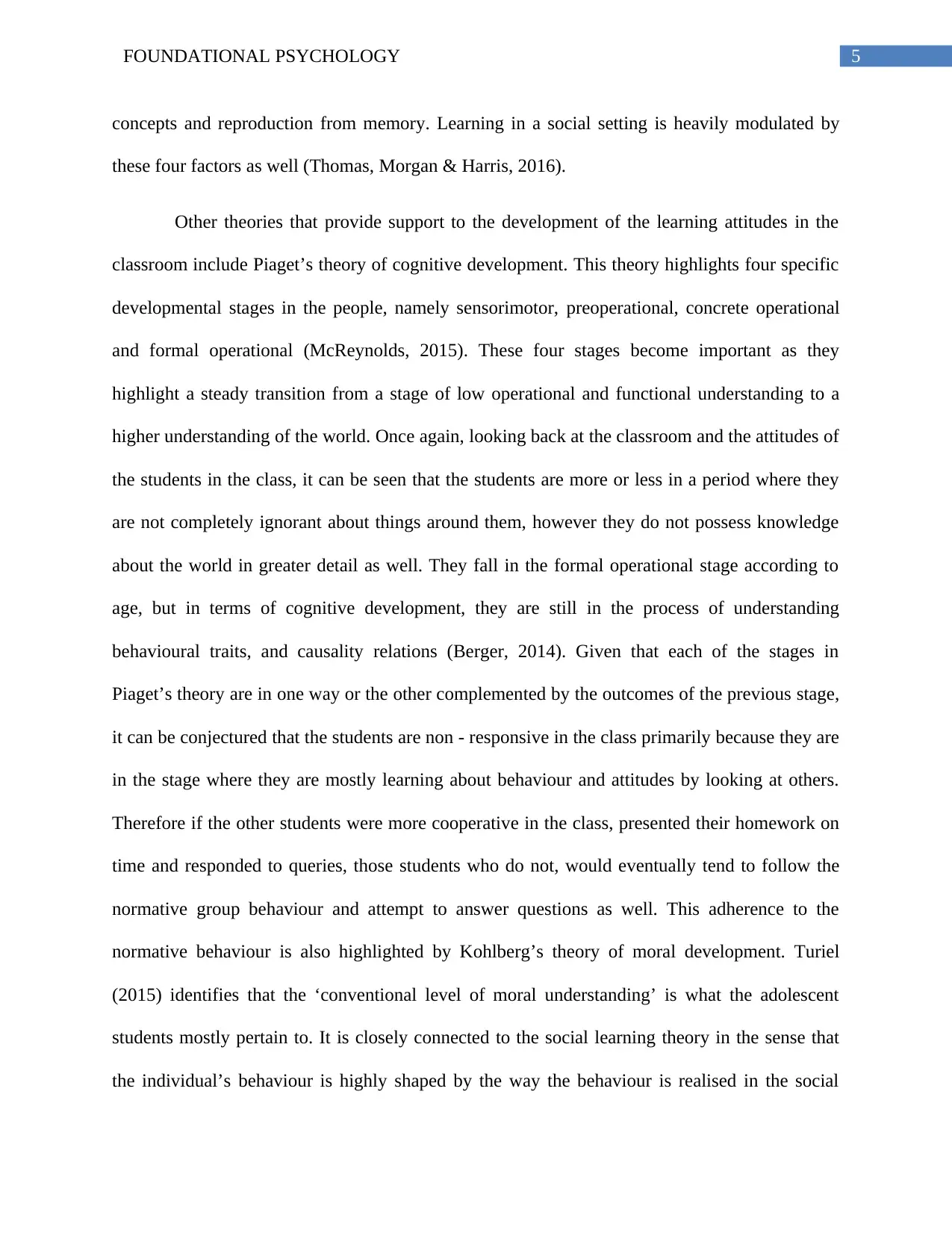
5FOUNDATIONAL PSYCHOLOGY
concepts and reproduction from memory. Learning in a social setting is heavily modulated by
these four factors as well (Thomas, Morgan & Harris, 2016).
Other theories that provide support to the development of the learning attitudes in the
classroom include Piaget’s theory of cognitive development. This theory highlights four specific
developmental stages in the people, namely sensorimotor, preoperational, concrete operational
and formal operational (McReynolds, 2015). These four stages become important as they
highlight a steady transition from a stage of low operational and functional understanding to a
higher understanding of the world. Once again, looking back at the classroom and the attitudes of
the students in the class, it can be seen that the students are more or less in a period where they
are not completely ignorant about things around them, however they do not possess knowledge
about the world in greater detail as well. They fall in the formal operational stage according to
age, but in terms of cognitive development, they are still in the process of understanding
behavioural traits, and causality relations (Berger, 2014). Given that each of the stages in
Piaget’s theory are in one way or the other complemented by the outcomes of the previous stage,
it can be conjectured that the students are non - responsive in the class primarily because they are
in the stage where they are mostly learning about behaviour and attitudes by looking at others.
Therefore if the other students were more cooperative in the class, presented their homework on
time and responded to queries, those students who do not, would eventually tend to follow the
normative group behaviour and attempt to answer questions as well. This adherence to the
normative behaviour is also highlighted by Kohlberg’s theory of moral development. Turiel
(2015) identifies that the ‘conventional level of moral understanding’ is what the adolescent
students mostly pertain to. It is closely connected to the social learning theory in the sense that
the individual’s behaviour is highly shaped by the way the behaviour is realised in the social
concepts and reproduction from memory. Learning in a social setting is heavily modulated by
these four factors as well (Thomas, Morgan & Harris, 2016).
Other theories that provide support to the development of the learning attitudes in the
classroom include Piaget’s theory of cognitive development. This theory highlights four specific
developmental stages in the people, namely sensorimotor, preoperational, concrete operational
and formal operational (McReynolds, 2015). These four stages become important as they
highlight a steady transition from a stage of low operational and functional understanding to a
higher understanding of the world. Once again, looking back at the classroom and the attitudes of
the students in the class, it can be seen that the students are more or less in a period where they
are not completely ignorant about things around them, however they do not possess knowledge
about the world in greater detail as well. They fall in the formal operational stage according to
age, but in terms of cognitive development, they are still in the process of understanding
behavioural traits, and causality relations (Berger, 2014). Given that each of the stages in
Piaget’s theory are in one way or the other complemented by the outcomes of the previous stage,
it can be conjectured that the students are non - responsive in the class primarily because they are
in the stage where they are mostly learning about behaviour and attitudes by looking at others.
Therefore if the other students were more cooperative in the class, presented their homework on
time and responded to queries, those students who do not, would eventually tend to follow the
normative group behaviour and attempt to answer questions as well. This adherence to the
normative behaviour is also highlighted by Kohlberg’s theory of moral development. Turiel
(2015) identifies that the ‘conventional level of moral understanding’ is what the adolescent
students mostly pertain to. It is closely connected to the social learning theory in the sense that
the individual’s behaviour is highly shaped by the way the behaviour is realised in the social
⊘ This is a preview!⊘
Do you want full access?
Subscribe today to unlock all pages.

Trusted by 1+ million students worldwide

6FOUNDATIONAL PSYCHOLOGY
groups. Therefore, the students are more inclined towards modifying their behaviour in a way
that they can adapt to the society (Mathes, 2019).
Application of operant conditioning, its strengths and weaknesses.
Operant conditioning is a highly effective method for behavioural modification as
proposed by the Psychologist B.F. Skinner. He stated that learning can happen based on the
stimuli that are being received from the surrounding environment. There are four parts of operant
conditioning that can be identified in the current context, namely positive reinforcement, positive
punishment, negative reinforcement and negative punishment. If the behavioural modification of
the classroom in the context of operant conditioning is looked at, the following outcomes can be
identified and expected.
Through positive and negative reinforcement.
Positive reinforcement happens when a certain kind of behaviour that results in the positive
outcomes are strengthened. Alternately, negative reinforcement happens when a particular
behaviour that can reduce the negative outcomes, are strengthened. Looking at Mr. Tan’s class, it
can be seen that the students, who are non - responsive, would start to respond actively in the
class if their grades are directly associated with active classroom participation. This would be an
example of positive reinforcement. Alternately, if the students are being punished and detained
for not producing their tasks and homework, then by promoting active participation in the class,
the students’ receiving of detention can be lessened. As a negative reinforcement, this would
promote active classroom participation
In the first case, if the students are provided with grades as rewards, the grades become
the environmental stimuli which promote the active participation of students in the class. In the
groups. Therefore, the students are more inclined towards modifying their behaviour in a way
that they can adapt to the society (Mathes, 2019).
Application of operant conditioning, its strengths and weaknesses.
Operant conditioning is a highly effective method for behavioural modification as
proposed by the Psychologist B.F. Skinner. He stated that learning can happen based on the
stimuli that are being received from the surrounding environment. There are four parts of operant
conditioning that can be identified in the current context, namely positive reinforcement, positive
punishment, negative reinforcement and negative punishment. If the behavioural modification of
the classroom in the context of operant conditioning is looked at, the following outcomes can be
identified and expected.
Through positive and negative reinforcement.
Positive reinforcement happens when a certain kind of behaviour that results in the positive
outcomes are strengthened. Alternately, negative reinforcement happens when a particular
behaviour that can reduce the negative outcomes, are strengthened. Looking at Mr. Tan’s class, it
can be seen that the students, who are non - responsive, would start to respond actively in the
class if their grades are directly associated with active classroom participation. This would be an
example of positive reinforcement. Alternately, if the students are being punished and detained
for not producing their tasks and homework, then by promoting active participation in the class,
the students’ receiving of detention can be lessened. As a negative reinforcement, this would
promote active classroom participation
In the first case, if the students are provided with grades as rewards, the grades become
the environmental stimuli which promote the active participation of students in the class. In the
Paraphrase This Document
Need a fresh take? Get an instant paraphrase of this document with our AI Paraphraser

7FOUNDATIONAL PSYCHOLOGY
second case, the reduction in the number of detention and punishments act as the stimuli which
will promote the students towards active participation.
Through positive and negative punishment.
If a negative behaviour is followed by an aversive stimulus, a positive punishment
occurs. Alternately, negative punishment occurs when, instead of providing an aversive stimulus,
a beneficial stimulus is taken away from the individual in the light of a negative behaviour.
Putting this in the context of Mr. Tan’s class, it can be seen that the students who are not
responsive in the class, if they are provided with a punishment, like detention or intervention or
even additional homework, the students would prefer to study and take part in the class in order
to avoid the punishment. Alternately, if because of non – participation, the students’ access to a
positive and rewarding stimulus is restricted, the students would try to amend that by taking
active participation in the class and producing their homework and assignments on time.
Here both the outcomes are promoting the active classroom participation, firstly in the
form of students trying to not receive something as a negative stimulus and in the second, in
order to gain back the positive stimulus that was taken away from them.
Strengths and weaknesses.
Operant conditioning is seen to take a more practical approach to solving behavioural
problems in cases like a classroom where the teacher has a certain level of autonomy and control
over the kinds of classroom behaviour that is permissible. This is where the key strength of the
theory lies. The other theories that have been discussed above look at the behaviour of the
student from the perspective of social mediation and cognitive development. This gives Operant
second case, the reduction in the number of detention and punishments act as the stimuli which
will promote the students towards active participation.
Through positive and negative punishment.
If a negative behaviour is followed by an aversive stimulus, a positive punishment
occurs. Alternately, negative punishment occurs when, instead of providing an aversive stimulus,
a beneficial stimulus is taken away from the individual in the light of a negative behaviour.
Putting this in the context of Mr. Tan’s class, it can be seen that the students who are not
responsive in the class, if they are provided with a punishment, like detention or intervention or
even additional homework, the students would prefer to study and take part in the class in order
to avoid the punishment. Alternately, if because of non – participation, the students’ access to a
positive and rewarding stimulus is restricted, the students would try to amend that by taking
active participation in the class and producing their homework and assignments on time.
Here both the outcomes are promoting the active classroom participation, firstly in the
form of students trying to not receive something as a negative stimulus and in the second, in
order to gain back the positive stimulus that was taken away from them.
Strengths and weaknesses.
Operant conditioning is seen to take a more practical approach to solving behavioural
problems in cases like a classroom where the teacher has a certain level of autonomy and control
over the kinds of classroom behaviour that is permissible. This is where the key strength of the
theory lies. The other theories that have been discussed above look at the behaviour of the
student from the perspective of social mediation and cognitive development. This gives Operant
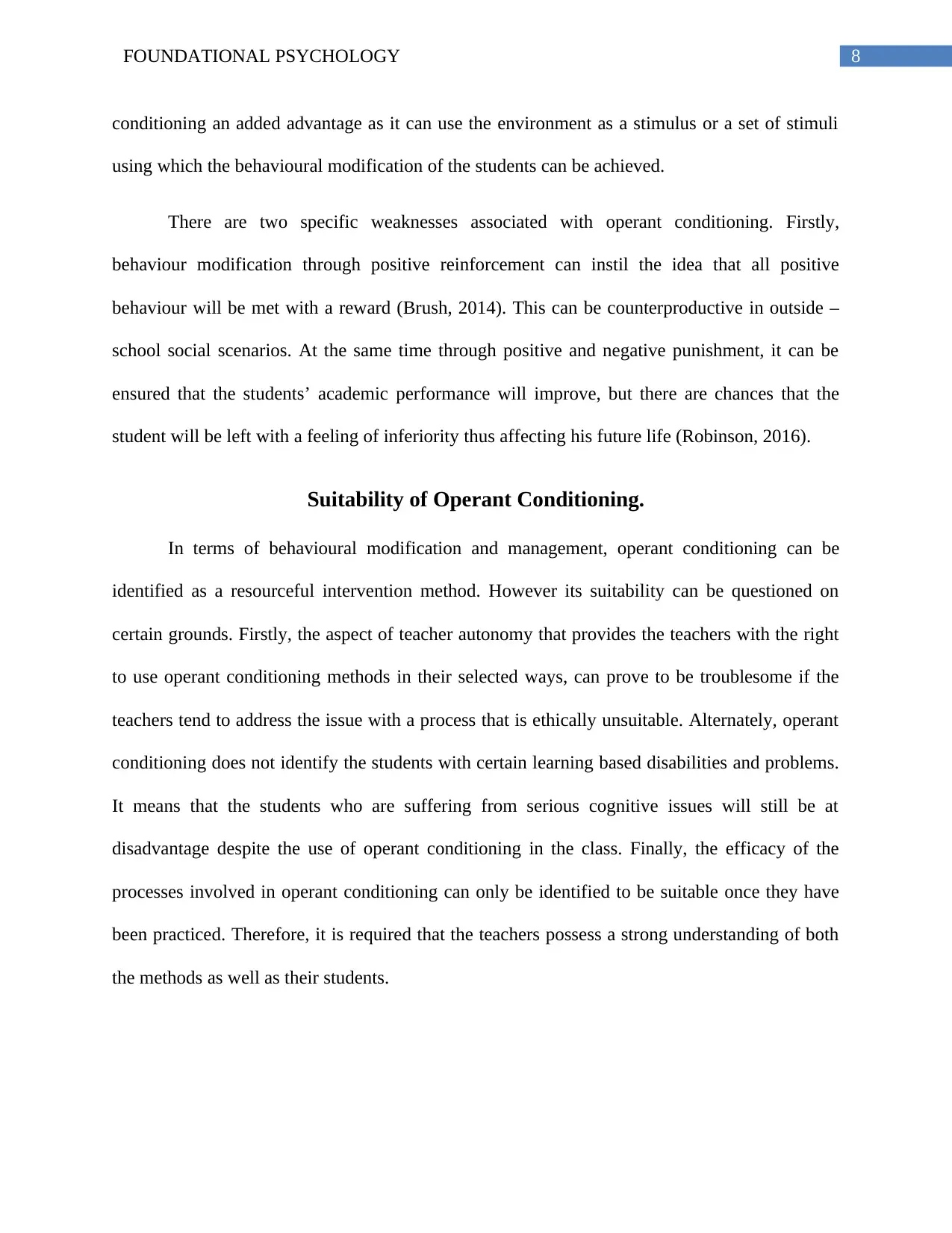
8FOUNDATIONAL PSYCHOLOGY
conditioning an added advantage as it can use the environment as a stimulus or a set of stimuli
using which the behavioural modification of the students can be achieved.
There are two specific weaknesses associated with operant conditioning. Firstly,
behaviour modification through positive reinforcement can instil the idea that all positive
behaviour will be met with a reward (Brush, 2014). This can be counterproductive in outside –
school social scenarios. At the same time through positive and negative punishment, it can be
ensured that the students’ academic performance will improve, but there are chances that the
student will be left with a feeling of inferiority thus affecting his future life (Robinson, 2016).
Suitability of Operant Conditioning.
In terms of behavioural modification and management, operant conditioning can be
identified as a resourceful intervention method. However its suitability can be questioned on
certain grounds. Firstly, the aspect of teacher autonomy that provides the teachers with the right
to use operant conditioning methods in their selected ways, can prove to be troublesome if the
teachers tend to address the issue with a process that is ethically unsuitable. Alternately, operant
conditioning does not identify the students with certain learning based disabilities and problems.
It means that the students who are suffering from serious cognitive issues will still be at
disadvantage despite the use of operant conditioning in the class. Finally, the efficacy of the
processes involved in operant conditioning can only be identified to be suitable once they have
been practiced. Therefore, it is required that the teachers possess a strong understanding of both
the methods as well as their students.
conditioning an added advantage as it can use the environment as a stimulus or a set of stimuli
using which the behavioural modification of the students can be achieved.
There are two specific weaknesses associated with operant conditioning. Firstly,
behaviour modification through positive reinforcement can instil the idea that all positive
behaviour will be met with a reward (Brush, 2014). This can be counterproductive in outside –
school social scenarios. At the same time through positive and negative punishment, it can be
ensured that the students’ academic performance will improve, but there are chances that the
student will be left with a feeling of inferiority thus affecting his future life (Robinson, 2016).
Suitability of Operant Conditioning.
In terms of behavioural modification and management, operant conditioning can be
identified as a resourceful intervention method. However its suitability can be questioned on
certain grounds. Firstly, the aspect of teacher autonomy that provides the teachers with the right
to use operant conditioning methods in their selected ways, can prove to be troublesome if the
teachers tend to address the issue with a process that is ethically unsuitable. Alternately, operant
conditioning does not identify the students with certain learning based disabilities and problems.
It means that the students who are suffering from serious cognitive issues will still be at
disadvantage despite the use of operant conditioning in the class. Finally, the efficacy of the
processes involved in operant conditioning can only be identified to be suitable once they have
been practiced. Therefore, it is required that the teachers possess a strong understanding of both
the methods as well as their students.
⊘ This is a preview!⊘
Do you want full access?
Subscribe today to unlock all pages.

Trusted by 1+ million students worldwide
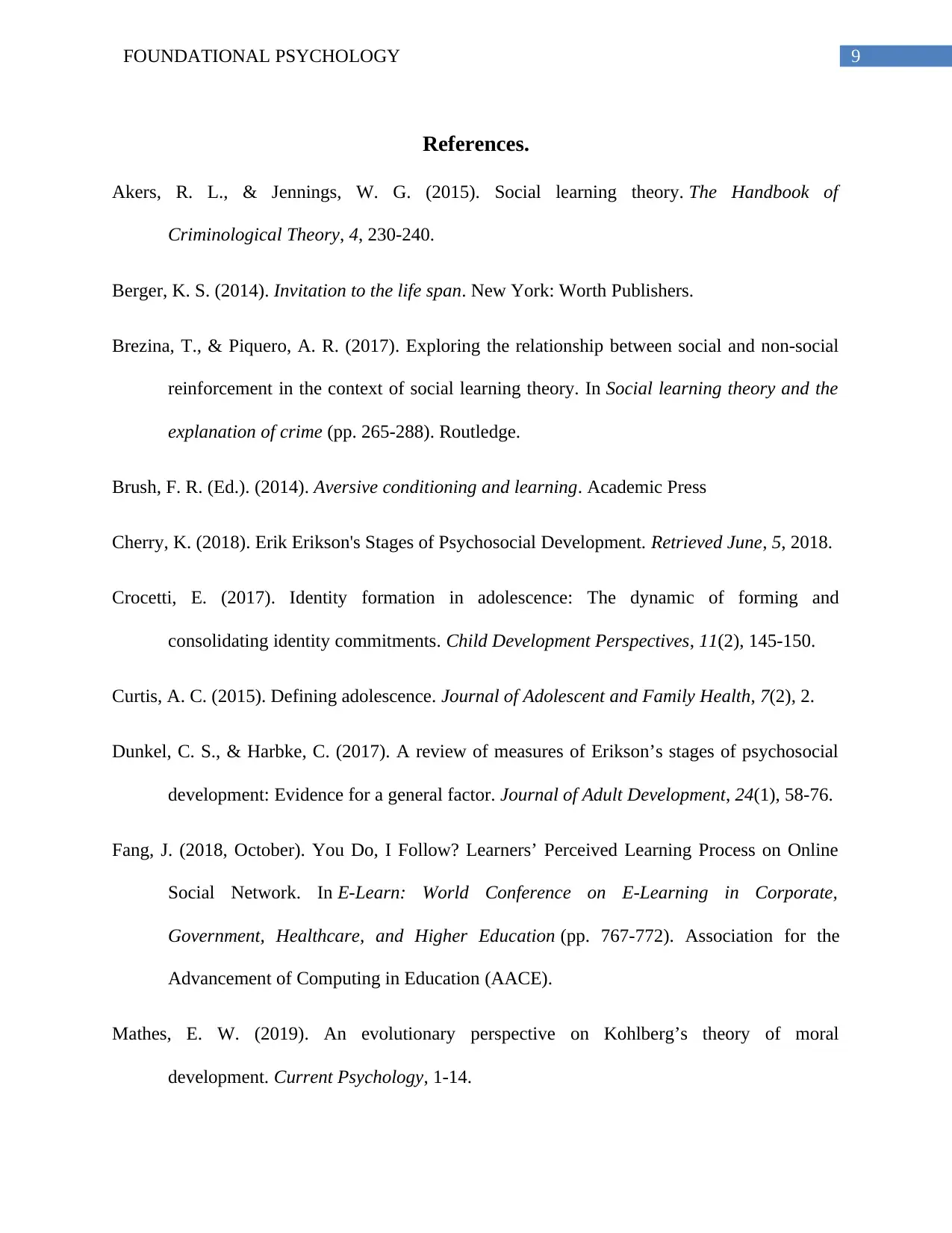
9FOUNDATIONAL PSYCHOLOGY
References.
Akers, R. L., & Jennings, W. G. (2015). Social learning theory. The Handbook of
Criminological Theory, 4, 230-240.
Berger, K. S. (2014). Invitation to the life span. New York: Worth Publishers.
Brezina, T., & Piquero, A. R. (2017). Exploring the relationship between social and non-social
reinforcement in the context of social learning theory. In Social learning theory and the
explanation of crime (pp. 265-288). Routledge.
Brush, F. R. (Ed.). (2014). Aversive conditioning and learning. Academic Press
Cherry, K. (2018). Erik Erikson's Stages of Psychosocial Development. Retrieved June, 5, 2018.
Crocetti, E. (2017). Identity formation in adolescence: The dynamic of forming and
consolidating identity commitments. Child Development Perspectives, 11(2), 145-150.
Curtis, A. C. (2015). Defining adolescence. Journal of Adolescent and Family Health, 7(2), 2.
Dunkel, C. S., & Harbke, C. (2017). A review of measures of Erikson’s stages of psychosocial
development: Evidence for a general factor. Journal of Adult Development, 24(1), 58-76.
Fang, J. (2018, October). You Do, I Follow? Learners’ Perceived Learning Process on Online
Social Network. In E-Learn: World Conference on E-Learning in Corporate,
Government, Healthcare, and Higher Education (pp. 767-772). Association for the
Advancement of Computing in Education (AACE).
Mathes, E. W. (2019). An evolutionary perspective on Kohlberg’s theory of moral
development. Current Psychology, 1-14.
References.
Akers, R. L., & Jennings, W. G. (2015). Social learning theory. The Handbook of
Criminological Theory, 4, 230-240.
Berger, K. S. (2014). Invitation to the life span. New York: Worth Publishers.
Brezina, T., & Piquero, A. R. (2017). Exploring the relationship between social and non-social
reinforcement in the context of social learning theory. In Social learning theory and the
explanation of crime (pp. 265-288). Routledge.
Brush, F. R. (Ed.). (2014). Aversive conditioning and learning. Academic Press
Cherry, K. (2018). Erik Erikson's Stages of Psychosocial Development. Retrieved June, 5, 2018.
Crocetti, E. (2017). Identity formation in adolescence: The dynamic of forming and
consolidating identity commitments. Child Development Perspectives, 11(2), 145-150.
Curtis, A. C. (2015). Defining adolescence. Journal of Adolescent and Family Health, 7(2), 2.
Dunkel, C. S., & Harbke, C. (2017). A review of measures of Erikson’s stages of psychosocial
development: Evidence for a general factor. Journal of Adult Development, 24(1), 58-76.
Fang, J. (2018, October). You Do, I Follow? Learners’ Perceived Learning Process on Online
Social Network. In E-Learn: World Conference on E-Learning in Corporate,
Government, Healthcare, and Higher Education (pp. 767-772). Association for the
Advancement of Computing in Education (AACE).
Mathes, E. W. (2019). An evolutionary perspective on Kohlberg’s theory of moral
development. Current Psychology, 1-14.
Paraphrase This Document
Need a fresh take? Get an instant paraphrase of this document with our AI Paraphraser
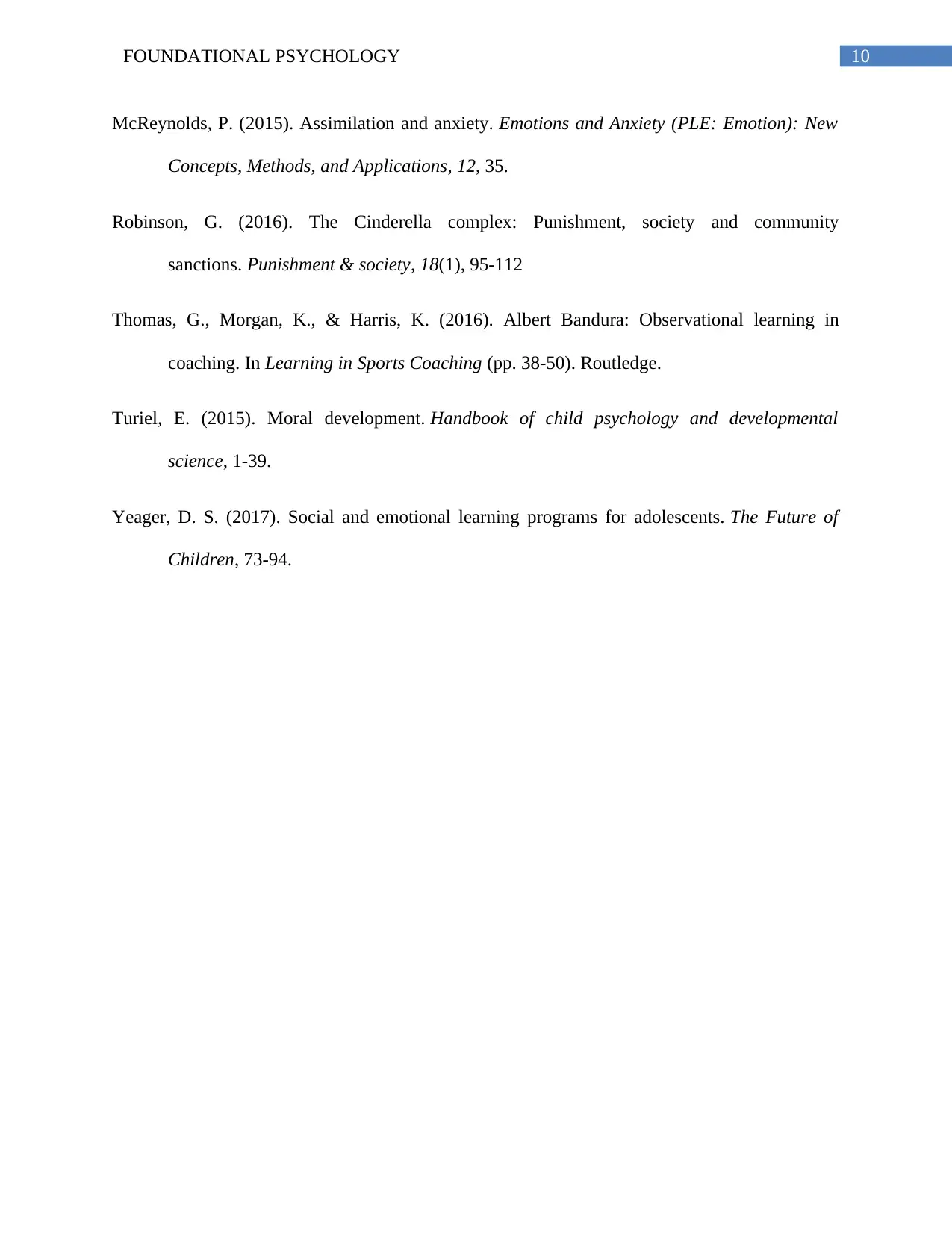
10FOUNDATIONAL PSYCHOLOGY
McReynolds, P. (2015). Assimilation and anxiety. Emotions and Anxiety (PLE: Emotion): New
Concepts, Methods, and Applications, 12, 35.
Robinson, G. (2016). The Cinderella complex: Punishment, society and community
sanctions. Punishment & society, 18(1), 95-112
Thomas, G., Morgan, K., & Harris, K. (2016). Albert Bandura: Observational learning in
coaching. In Learning in Sports Coaching (pp. 38-50). Routledge.
Turiel, E. (2015). Moral development. Handbook of child psychology and developmental
science, 1-39.
Yeager, D. S. (2017). Social and emotional learning programs for adolescents. The Future of
Children, 73-94.
McReynolds, P. (2015). Assimilation and anxiety. Emotions and Anxiety (PLE: Emotion): New
Concepts, Methods, and Applications, 12, 35.
Robinson, G. (2016). The Cinderella complex: Punishment, society and community
sanctions. Punishment & society, 18(1), 95-112
Thomas, G., Morgan, K., & Harris, K. (2016). Albert Bandura: Observational learning in
coaching. In Learning in Sports Coaching (pp. 38-50). Routledge.
Turiel, E. (2015). Moral development. Handbook of child psychology and developmental
science, 1-39.
Yeager, D. S. (2017). Social and emotional learning programs for adolescents. The Future of
Children, 73-94.
1 out of 11
Related Documents
Your All-in-One AI-Powered Toolkit for Academic Success.
+13062052269
info@desklib.com
Available 24*7 on WhatsApp / Email
![[object Object]](/_next/static/media/star-bottom.7253800d.svg)
Unlock your academic potential
Copyright © 2020–2025 A2Z Services. All Rights Reserved. Developed and managed by ZUCOL.




